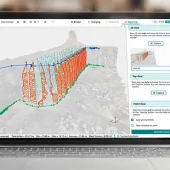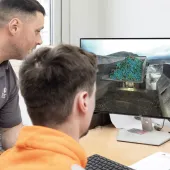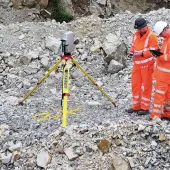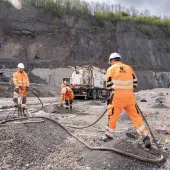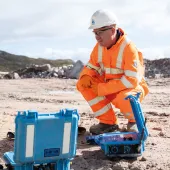A Perfect Partnership
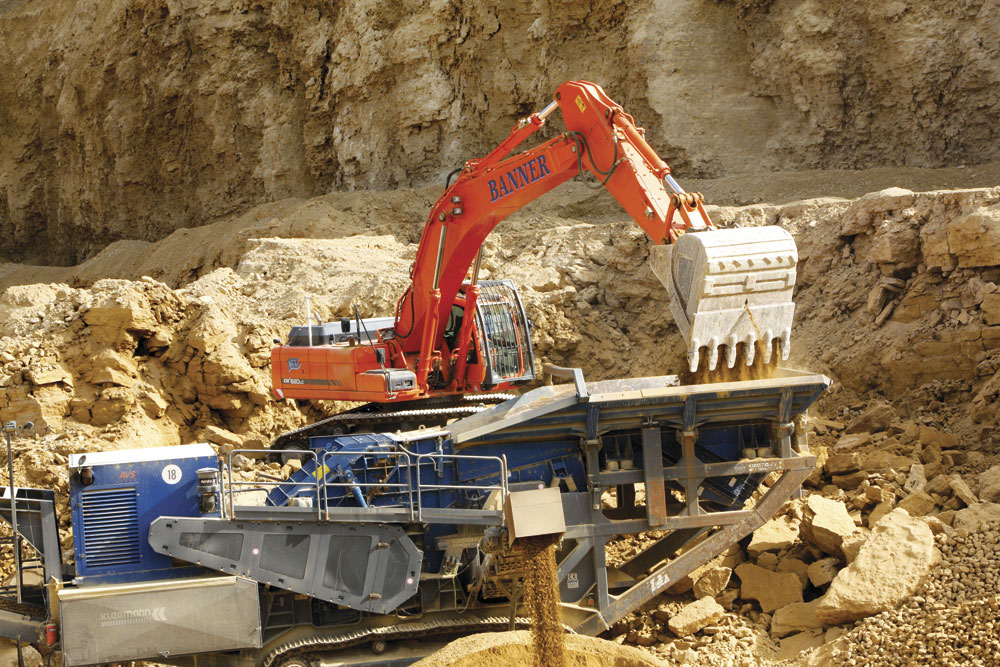
Collaboration delivers optimized blasting process at Thrislington Quarry
By Ian Brown, Lafarge Aggregates; Jo Banner, Banner Contracts; and Dr Rob Farnfield and Martin Cooper, EPC-UK
There is sufficient published global research confirming that the use of electronic detonators in quarry blasting results in a reduction in the overall cost of rock breaking, yet the take-up of this technology in the UK has been poor. For the most part, electronic detonator systems have been limited to those sites that require strict control of the environmental impacts of blasting.
This article describes the process undertaken at a quarry that relied on the effective collaboration between three independent companies, who each placed the single goal of optimizing the entire process above their own individual interests while maintaining and, where possible, improving safety standards. By observation, discussion and experimentation, the use of electronic detonators to control vibration levels in one area of the quarry evolved, while the same technology was used to optimize the rock-breaking process in another area.
The partners
The three independent partners involved were quarry operators Lafarge Aggregates; explosives suppliers EPC-UK; and crushing contractors Banner Contracts.
Established in France in 1833 and now operating in 70 countries, Lafarge are global producers of cement, aggregates, concrete and asphalt. The company’s key objectives are: zero harm; product innovation; and industrial excellence. Blast optimization is essential to achieving these goals.
EPC Groupe were established in 1893, their core activity being the manufacture and supply of commercial explosives and tailor-made services to the mining, cement, aggregates and civil engineering industries. The group has activities in Europe, Africa and the Middle East, and has operated in the UK for more than 100 years.
Banner Contracts are a family-run company with more than 30 years’ experience in the construction and quarrying industries. The main activities of the company are: contract crushing, screening and washing of aggregates; and earthmoving and related plant-hire services.
Thrislington Quarry
Lafarge’s Thrislington Quarry was opened in 1954 to extract magnesian limestone from an area near Ferryhill. The quarry, which covers an area of 112ha, plays an important role in mineral supply in Co. Durham and about a third of the limestone extracted from the site is a high-grade variety (known as industrial dolomite). This is processed in the kilns at the adjoining works to produce burnt dolomite which is of considerable importance to the steel industry.
Lafarge have gained planning permission to extend the life of the quarry beyond 2015 and to work an area east of the A1(M). Over a period of 32 years the company will extract 29 million tonnes from this new extension, which will involve the building of a 200m long tunnel under the A1(M).
Electronic detonators
It is widely recognized that the use of electronic detonators has a number of significant advantages compared with detonators based on shock-tube technology. The following is a comparison of the key aspects:
Testability
Most electronic detonator systems are fully testable with two-way communication between the detonator and the exploder. Because the functioning of the entire system can be confirmed prior to blasting, the possibility of misfires is significantly reduced. In contrast, shock-tube systems have no testability and rely on a simple visual check before firing.
Accuracy
Delay times in electronic detonators are generated by means of a digital chip housed inside the detonator, which provides an initiation accuracy to a fraction of a millisecond. Shock-tube-based detonators rely on the burn time of a pyrotechnical delay element to generate the required delay. The reliance on a pyrotechnical delay element means that such detonators are subject to a significant degree of so-called ‘scatter’. Trials with shock-tube detonators show that in a single row of blastholes, the degree of scatter is generally sufficient for at least one of the holes to initiate out of sequence.
Flexible initiation pattern
The use of electronic detonators results in complete flexibility in the choice of initiation pattern, with almost any combination of inter-hole and inter-row delay being possible. In contrast, with shock-tube systems the choice of delays is limited to those provided by the detonator manufacturer.
Cost
While electronic systems are generally more expensive than shock-tube-based systems, their use provides significant benefits in terms of blast and vibration control. When viewed in the context of overall process costs, the result is a lower rock production cost.
Hotshot electronic detonator system
The electronic detonator system used in the work described in this article is the Hotshot system manufactured in South Africa by Detnet and supplied in the UK by EPC-UK. The Hotshot system is an auto-programmable system similar in operation to a shock-tube system by using inter-hole and inter-row delays. Compared with a shock-tube system, however, the difference is that the Hotshot system is both fully testable and accurate, and provides complete flexibility in the choice of delays employed.
Hybrid initiation
In the UK, EPC-UK have pioneered the use of a combination of electronic and shock-tube detonators in quarry blasting with a so-called ‘hybrid’ system. With this system, each charge or deck of explosives has a single electronic detonator and a single shock-tube (in-hole) detonator. The shock-tube detonator is left unconnected unless the electronic system indicates that there is a problem with the single in-hole electronic detonator. When such a problem is discovered, a replacement electronic detonator is connected to the in-hole shock-tube detonator and the firing time adjusted to take into account the delay time of the shock-tube detonator. This system has the advantage of reducing cost while retaining all the advantages of employing electronic detonators. The hybrid system has been employed in the work outlined in this article.
Crushing process
As with any quarry operation, if safety is held as the primary concern, efficiency and cost savings will follow as a result. It is often the case that where a quarry employs contract crushing, the key driver is to minimize drilling and blasting costs, as the cost of the crushing operation is then fixed and the quality of the blast is no longer a variable that affects it.
This is a very short-term view and often results in increased costs, not only for the crushing contractor, but also for the quarry owner.
Safety in a quarry is a team effort demanding joined-up thinking in order to be successful. Nowhere is this more apparent than in the relationship between the crushing operations and the drilling and blasting operations. The crushing contractors can do all they can to be safe, but the biggest hazards they encounter are found in the blast pile and at the rock face, ie outputs of the drilling and blasting operation. The risks from a poor face that requires extensive dressing, the handling of oversize stone in the muckpile and subsequent bridging of the primary crusher are self-evident and have resulted in numerous fatalities in the industry.
The use of the Hotshot system at Thrislington Quarry has resulted in a muckpile with improved fragmentation, and cleaner faces. The benefits in terms of safety are difficult to quantify in terms of monetary value. Cleaner faces and less oversize mean less time spent dressing faces, less time spent handling and breaking oversize stone, and less bridging in the primary crusher. These are all activities where the risks must be managed; eliminating the activity altogether clearly being the most preferable solution.
However, in terms of efficiency savings and improved production, the benefits of the Hotshot system are more tangible, as outlined below:
Improved fragmentation
Improved fragmentation means the face excavator spends less time handling and breaking oversize stone. While handling oversize material the excavator is not feeding the primary crusher. Every minute the crusher spends running empty carries with it a cost in terms of lost production for Banner Contracts and a cost in terms of wasted fuel for Lafarge.
Prior to the use of electronic detonators, the pile of shot rock was often difficult to dig due to poor fragmentation. The face excavator would spend time winning the rock to feed the jaw crusher. As a result, the crusher could run empty for periods of time, with the costs in terms of lost production and higher fuel usage being clearly evident. In addition, the stresses placed upon the face machine would eventually result in premature failure and excessive wear of components. This was especially the case on short faces with vibration issues.
Cleaner faces
The quality of the faces left behind after blasting with the Hotshot system means less time is spent dressing faces, resulting in improved production due to reduced time demands on the face excavator.
Bigger blasts
The ability to drop bigger blasts with confidence has led to a further saving in downtime. The time taken to pull plant out for a blast and then to set the plant up again can amount to several hours. The savings attributable to eliminating some of this downtime are self-evident.
The combined benefit in terms of production gains can be as much as 100 tonnes per day when compared with a poor shot using shock-tube initiation.
Blast Optimization
Prior to the start of the optimization process in the southern part of Thrislington Quarry, a typical blast consisted of two rows of five 125mm diameter holes. Sub-drill of 1.0m was generally employed along with a burden of 4.5m and a spacing of 5.0m. The hole loading consisted of a small packaged explosive base charge with a column charge of site-mixed ANFO and 3.0m of stemming. As is typical at most quarries, over the years attempts had been made to optimize and improve the blast design, in this case by increasing blast size and reducing the degree of sub-drill. However, although these changes did make some improvements, the results were not consistent and usually resulted in occasional blasts with poor performance.
It is also worth noting that Thrislington shares a drill rig with two other quarries, so blast size is very important in order to minimize the cost of rig transport between sites.
The blast optimization process followed a simple approach, progressing in phases from the existing blast design based on shock-tube detonators, to a fully optimized design based on electronic detonators.
Phase 1: Change to electronic detonators
Apart from the fact that the shock-tube system was replaced by an electronic system (hybrid), the blasts fired were identical to the original design in all other aspects. The delay pattern used 16ms along the row and 40ms between rows. This simple change resulted in a blast with greatly enhanced fragmentation, as reported by the crushing contractor, but a muckpile profile that was not ideal for the loader/crusher combination employed – too low and too wide a spread. Clearly, the cost per tonne of drilling and blasting had increased due to the use of electronic detonators, but the crushing contractor considered that this was more than offset by the increased crusher throughput, reduced downtime and reduced fuel consumption. The quarry also reported that the post-blast face was much improved.
Phase 2: Increase burden and spacing
Initially, the burden was increased by 0.5m while continuing to employ the hybrid initiation system, resulting in a cost per blasted tonne equal to that previously obtained. Blasts fired using this design were also reported to produce enhanced fragmentation and improved post-blast face conditions. The post-blast muckpile shape was more suitable for the combination of excavator and crusher employed.
Subsequent blasts were designed with an additional 0.5m added to the spacing, resulting in an overall blasting cost that was less than the original shock-tube-based design.
Phase 3: Increase blast size
To reduce drill rig movements, and therefore cost, blast size is critical at this quarry. It was determined that the number of rows and the number of holes per row should, if possible, be increased. Typically, this resulted in blasts with three rows of 13 holes and included one blast with seven rows of 10 holes. This increase in blast size did not have an adverse impact on either fragmentation or post-blast face conditions.
Phase 4: Remove sub-drill and all packaged explosive
As a final stage in the optimization process, it was decided to remove both the sub-drill and packaged explosives from the design. This change reduced costs even further without causing any noticeable reduction in blast performance or problems with control of the quarry floor.
Consistent Performance
The quarry continues to use the optimized blast design in conjunction with electronic detonators and reports that good, consistent blast performance continues.
Relative costs
An idea of the relative costs for each phase of the trial is shown in table 1. It should be noted that these costs do not include any adjustment for reductions in rig movements due to increasing blast size.
Conclusion
The simple trials carried out at Thrislington have shown that, with good collaboration between all three interested parties, it has been possible to add value to the rock-breaking process by the application of electronic detonator technology.
The trials at Thrislington have resulted in reductions in the cost of both blasting and crushing. Equally as important, it is clear that the use of electronic detonators has improved the condition of the post-blast faces, resulting in enhanced safety for site operations. The increase in blast size has also improved safety by reducing the total area of new face per tonne of rock blasted.
Experience tends to suggest that the situation at Thrislington is unusual in that costs have been reduced for both the blasting operation and crushing – a synergy which has only been realized as a result of the effective collaboration between all parties. However, other trials have shown that while blasting costs may go up with the application of electronic detonators, the overall cost of the rock-breaking process reduces.


